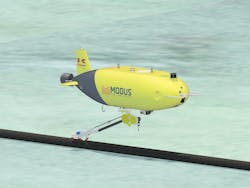Modus Subsea Services Ltd. has acquired two SPICE (Subsea Precise Inspector with Close Eyes) autonomous underwater vehicle (AUV) systems from Kawasaki Heavy Industries Ltd. According to Kawasaki, SPICE is the world’s first AUV equipped with a robot arm for performing subsea pipeline inspections. An inspection tool unit is fitted with close-range sensors at the end of the robot arm. SPICE controls the robot arm autonomously to track the pipeline and perform inspection operations.
The AUV is about 5.6 m (18.3 ft) long, 1.4 m (4.6 ft) wide, and 1.1 m (3.6 ft) tall.
In addition, it is operated using a Kawasaki-developed docking station, which increases inspection operation efficiency and reduces cost requirements.
3D at Depth Inc. has purchased a Sabertooth hybrid AUV/ROV from Saab Seaeye. The hybrid AUV/ROV is equipped as a containerized spread to transform any vessel of opportunity into a survey and inspection platform in less than 18 hours. This allows deepwater assets and offshore wind operators to reduce their costs, risks, and carbon footprint.
Neil Manning, COO of 3D at Depth, said: “The hybrid AUV/ROV coupled with 3D at Depth’s patented SL Subsea LiDAR laser with remote sensing technology adds an extra layer of measurement and repeatability.”
The 3,000 m (9,842 ft)-rated dual-hull system features an inertial navigation package with fixed offsets to the sensor payload, which includes the company’s SL3 LiDAR laser, ultra-high resolution multibeam echosounder, side scan sonar, multiple camera and light solutions, and a methane leak detection sensor.
The sensor payload is fully integrated with customized electronics and software that allows the Sabertooth to act as one tool, enable one set-up, and ultimately require one mobilization for multiple survey deliverables, the company said.
MCS has introduced the mini-ROV MiniSpector, which is designed to cut the costs of subsea inspection and 3D metrology. The vehicle can be launched from a platform, which reduces the reliance on additional vessels and equipment.
MCS CEO Wael Bakr said: “The MiniSpector has been designed to be easily carried and deployed and contains built-in 3D Photo Realistic Cloud technology for precise 3D measurement…”
The system provides measurements subsea, up to fabrication accuracy, he added, with a claimed beneficial impact on overall project efficiency and duration, particularly in deepwater measurements.
“Example of tasks the MiniSpector can deliver seamlessly include HD general visual inspection and close video inspection, spool metrology, platform approaches, and riser installation.
“With seven horizontal and vertical thrusters [it] provides full control, increased vehicle maneuverability, stability, and payload capabilities to withstand higher currents than other mini ROVs on the market.”
Blue Ocean Seismic Services (BOSS) has completed sea trials of a test prototype version of its AUV offshore Australia. BOSS’ shareholders are Blue Ocean Monitoring, bp Ventures, and Woodside Energy.
The self-repositioning autonomous underwater nodes, designed for long endurance, will perform offshore seismic surveys for oil and gas exploration and reservoir optimization, also serving to identify and monitor potential carbon storage sites beneath the seabed.
During the trials, the testbed ocean bottom seismic robotic vehicle (tOBSrV) traversed a series of waypoints, while simultaneously providing status updates to a master vessel. It also logged flight and engineering data which is being used for further systems development.
The trials also validated BOSS’ electronics and software system, confirming its efficacy underwater. Collected data collected will support the design and development of the final product ahead of commercialization.
The next priority will be the construction and testing of 10+ alpha prototypes, followed by a seismic sea trial in the North Sea.
Erin Hallock, managing partner, bp Ventures said: “Once in production, this vehicle will make global offshore oil and gas exploration, reservoir optimization and other marine seismic applications cheaper, faster, safer, and importantly, less carbon intensive.”
Petrobras orders Marlim/Voador subsea equipment
Petrobras has awarded TechnipFMC and Baker Hughes contracts for the Marlim and Voador field-revitalization project in the Campos basin offshore Brazil.
TechnipFMC will supply up to eight manifolds for production and injection, using the all-electric robotic valve controller (RVC). The contract also includes associated tools, spares, and services. The RVC replaces traditional subsea hydraulics, as well as thousands of mechanical parts, while providing real-time data and analysis on system performance. This results in a manifold that is smaller, less complex and costly with a reduced carbon footprint. Also, the RVC’s software can be remotely upgraded and maintained subsea, increasing the overall reliability and availability of the system, the company said.
Baker Hughes will provide up to five subsea production and injection manifold systems, featuring a lightweight and compact design that allows for installation from smaller vessels and integrated hydraulic connection systems and retrievable choke modules. The manifold systems, which will be fabricated, tested and assembled in Jandira, Brazil, will include the company’s vertical mechanical clamp connection system. In addition, the company will deliver 32 Modpod subsea control modules powered by SemStar5 technology, and manufactured at its Nailsea facility in Bristol, UK.
About the Author
Jessica Stump
Editor
Jessica Stump is editor of Offshore Magazine. She uploads and writes news to the website, assembles surveys and electronic newsletters, and writes and edits articles for the magazine. She was the summer editorial intern at Offshore in 2009 and 2010 before joining full time in April 2011. She has a journalism degree from Texas Tech University.

